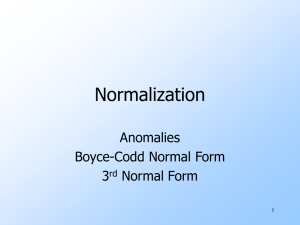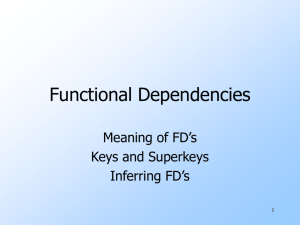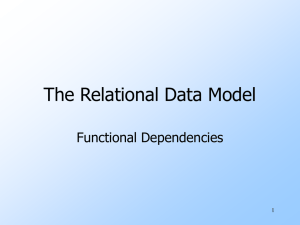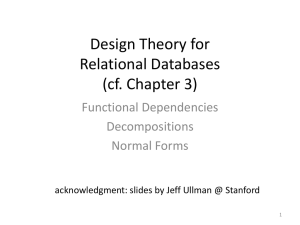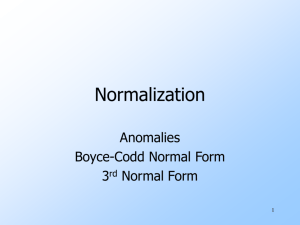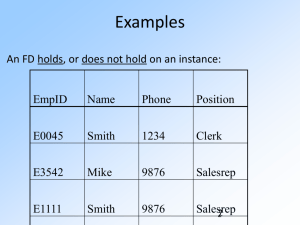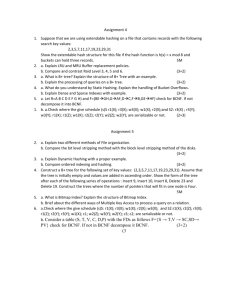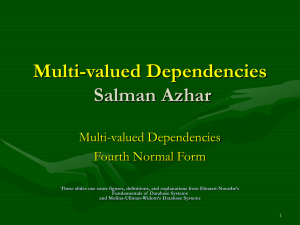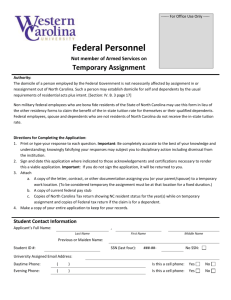4NF and 5NF - Department of Computer Science
advertisement
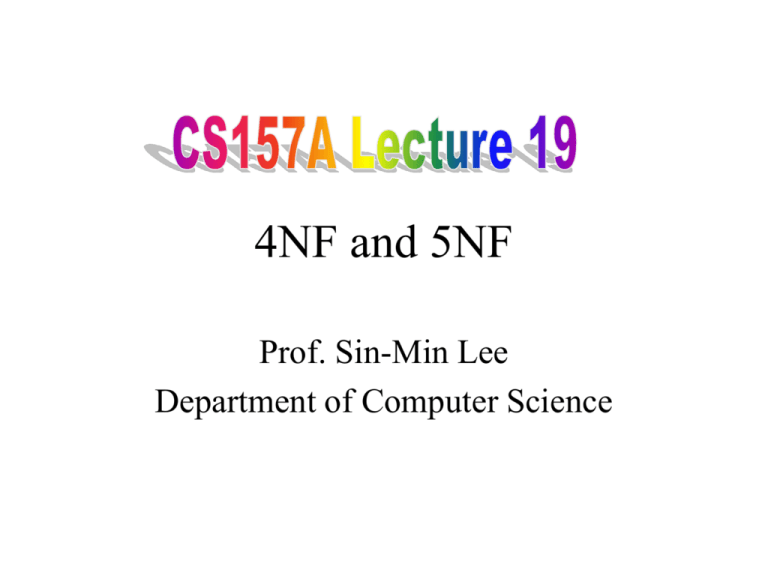
4NF and 5NF
Prof. Sin-Min Lee
Department of Computer Science
Schedule
• Today: Jan. 15 (T)
– Normal Forms, Multivalued Dependencies.
– Read Sections 3.6-3.7. Assignment 1 due.
• Jan. 17 (TH)
– Relational Algebra.
– Read Chapter 5. Project Part 1 due.
• Jan. 22 (T)
– SQL Queries.
– Read Sections 6.1-6.2. Assignment 2 due.
• Jan. 24 (TH)
– Subqueries, Grouping and Aggregation.
– Read Sections 6.3-6.4. Project Part 2 due.
Goal = BCNF =Normalization
Boyce-Codd Normal Form =
all FD’s follow from the fact “key everything.”
• Formally, R is in BCNF if for every nontrivial FD
for R, say X A, then X is a superkey.
– “Nontrivial” = right-side attribute not in left side.
Why?
1. Guarantees no redundancy due to FD’s.
2. Guarantees no update anomalies = one occurrence
of a fact is updated, not all.
3. Guarantees no deletion anomalies = valid fact is
lost when tuple is deleted.
Example
of
Problems
add r
bee rsLiked man f
favori teBee r
Drinkers(name, addr, beersLiked, manf, favoriteBeer)
nam e
Ja neway
Ja neway
Spock
Voyag er
???
Ente rprise
Bud
Wicke dAle
Bud
A.B.
Pete 's
???
Wicke dAle
???
Bud
FD’s:
1. name addr
2. name favoriteBeer
3. beersLiked manf
• ???’s are redundant, since we can figure them out from the FD’s.
• Update anomalies: If Janeway gets transferred to the Intrepid,
will we change addr in each of her tuples?
• Deletion anomalies: If nobody likes Bud, we lose track of Bud’s
manufacturer.
Each of the given FD’s is a BCNF violation:
• Key = {name, beersLiked}
– Each of the given FD’s has a left side that is a proper
subset of the key.
Another Example
Beers(name, manf, manfAddr).
• FD’s = name manf, manf manfAddr.
• Only key is name.
– Manf manfAddr violates BCNF with a left side
unrelated to any key.
Decomposition
to
Reach
BCNF
Setting: relation R, given FD’s F.
Suppose relation R has BCNF violation X B.
• We need only look among FD’s of F for a
BCNF violation, not those that follow from F.
• Proof: If Y A is a BCNF violation and
follows from F, then the computation of Y+
used at least one FD X B from F.
– X must be a subset of Y.
– Thus, if Y is not a superkey, X cannot be a superkey
either, and X B is also a BCNF violation.
1. Compute X+.
– Cannot be all attributes – why?
2. Decompose R into X+ and (R–X+) X.
R
X X+
3. Find the FD’s for the decomposed relations.
– Project the FD’s from F = calculate all
consequents of F that involve only attributes
from X+ or only from (RX+) X.
Example
R = Drinkers(name, addr, beersLiked, manf,
favoriteBeer)
F=
1. name addr
2. name favoriteBeer
3. beersLiked manf
Pick BCNF violation name addr.
• Close the left side: name + = name addr favoriteBeer.
• Decomposed relations:
Drinkers1(name, addr, favoriteBeer)
Drinkers2(name, beersLiked, manf)
• Projected FD’s (skipping a lot of work that leads nowhere
interesting):
– For Drinkers1: name addr and name favoriteBeer.
– For Drinkers2: beersLiked manf.
(Repeating)
• Decomposed relations:
Drinkers1(name, addr, favoriteBeer)
Drinkers2(name, beersLiked, manf)
• Projected FD’s:
– For Drinkers1: name addr and name
favoriteBeer.
– For Drinkers2: beersLiked manf.
• BCNF violations?
– For Drinkers1, name is key and all left sides of
FD’s are superkeys.
– For Drinkers2, {name, beersLiked} is the key,
and beersLiked manf violates BCNF.
Decompose Drinkers2
• First set of decomposed relations:
Drinkers1(name, addr, favoriteBeer)
Drinkers2(name, beersLiked, manf)
• Close beersLiked+ = beersLiked, manf.
• Decompose Drinkers2 into:
Drinkers3(beersLiked, manf)
Drinkers4(name, beersLiked)
• Resulting relations are all in BCNF:
Drinkers1(name, addr, favoriteBeer)
Drinkers3(beersLiked, manf)
Drinkers4(name, beersLiked)
One FD structure causes 3NF
problems:
• If you decompose, you can’t check all the FD’s only
in the decomposed relations.
• If you don’t decompose, you violate BCNF.
Abstractly: AB C and C B.
• Example 1: title city theatre and
theatre city.
• Example 2: street city zip,
zip city.
Keys: {A, B} and {A, C}, but C B has a left side that
is not a superkey.
• Suggests decomposition into BC and AC.
– But you can’t check the FD AB C in only these relations.
Example
street
zip
54 5 Te ch Sq.
02 139
A = street,54B5 Te=chcity,
C
= zip.
Sq.
02 138
city
zip
Camb ridge
Camb ridge
02 138
02 139
zip city
street city zip
Join:
city
street
zip
Cambridge
Cambridge
545 Tech Sq.
545 Tech Sq.
02138
02139
“Elegant” Workaround
Define the problem away.
• A relation R is in 3NF iff (if and only if)
for every nontrivial FD X A, either:
1. X is a superkey, or
2. A is prime = member of at least one key.
• Thus, the canonical problem goes away:
you don’t have to decompose because all
attributes are prime.
What 3NF Gives You
There are two important properties of a decomposition:
1. We should be able to recover from the decomposed
relations the data of the original.
–
2.
•
•
•
Recovery involves projection and join, which we shall defer until
we’ve discussed relational algebra.
We should be able to check that the FD’s for the original
relation are satisfied by checking the projections of those
FD’s in the decomposed relations.
Without proof, we assert that it is always possible to
decompose into BCNF and satisfy (1).
Also without proof, we can decompose into 3NF and
satisfy both (1) and (2).
But it is not possible to decompose into BNCF and get
both (1) and (2).
–
Street-city-zip is an example of this point.
Multivalued Dependencies
The multivalued dependency X Y holds
in a relation R if whenever we have two
tuples of R that agree in all the attributes of
X, then we can swap their Y components
and get two new tuples that are also in R.
X
Y
others
Example
Drinkers(name, addr, phones, beersLiked)
with MVD Name phones. If Drinkers has
the two tuples:
name addr
sue
a
sue
a
phones
p1
p2
beersLiked
b1
b2
it must also have the same tuples with phones
components swapped:
name addr
sue
a
sue
a
phones
p2
p1
beersLiked
b1
b2
Note: we must check this condition for all pairs of tuples
that agree on name, not just one pair.
MVD Rules
1.Every FD is an MVD.
– Because if X Y, then swapping Y’s between
tuples that agree on X doesn’t create new tuples.
– Example, in Drinkers: name addr.
2.Complementation: if X Y, then X Z,
where Z is all attributes not in X or Y.
– Example: since name phones
holds in Drinkers, so does
name addr beersLiked.
Splitting
Doesn’t
Hold
Sometimes you need to have several attributes on the right of an
MVD. For example:
Drinkers(name, areaCode, phones, beersLiked,
beerManf)
name
Sue
Sue
Sue
Sue
•
areaCode
831
831
408
408
phones
555-1111
555-1111
555-9999
555-9999
beersLiked
Bud
Wicked Ale
Bud
Wicked Ale
name areaCode phones holds, but neither
name areaCode nor name phones do.
beerManf
A.B.
Pete’s
A.B.
Pete’s
Eliminate redundancy due to4NF
multiplicative effect of MVD’s.
• Roughly: treat MVD’s as FD's for decomposition, but not
for finding keys.
• Formally: R is in Fourth Normal Form if whenever MVD
X Y is nontrivial (Y is not a subset of X, and X Y is
not all attributes), then X is a superkey.
– Remember, X Y implies X Y, so 4NF is more stringent
than BCNF.
• Decompose R, using
4NF violation X Y,
into XY and X (R—Y).
R
X Y
Example
Drinkers(name, addr, phones, beersLiked)
• FD: name addr
• Nontrivial MVD’s: name phones and
name beersLiked.
• Only key: {name, phones, beersLiked}
• All three dependencies above violate 4NF.
• Successive decomposition yields 4NF relations:
D1(name, addr)
D2(name, phones)
D3(name, beersLiked)
HIGHER NORMAL FORMS
1NF
2NF 3NF BCNF 4NF 5NF
functional
dependencies
multivalued
dependencies
join
dependencies
ASSUMPTIONS
• 24-HOUR FLIGHT-TIMETABLE, ALL FLIGHTS EVERY DAY
• ALL PLANES TAKE-OFF AND LAND (BUT DO NOT CRASH)
• NO AIRPORT IS LANDING-ONLY & NO AIRPORT IS TAKE-OFF-ONLY
TTAB (ORG) = TTAB (DST)
• THERE IS AT LEAST ONE TIME DELAY ENTRY FOR EVERY FLIGHT
• SIMILARLY IN WEATHER REPORT HISTORY
• IF NO TWO FLIGHTS CAN TAKE OFF AT THE SAME TIME IN THE SAME AIRPORT
WES CAN BE POSTED TO FLIGHT AND WEATHER@ORIGIN ELIMINATED
AWARD
UNIVERSITY
DISCIPLINE DEGREE
Old Town
Computing
BSc
Old Town
Mathematics
PhD
New City
Computing
PhD
Old Town
Computing
PhD
teaches (UNIVERSITY, DISCIPLINE)
is_read_for (DISCIPLINE, DEGREE)
awards (UNIVERSITY, DEGREE)
teaches (NewCity, Computing) = true
awards (NewCity, PhD) = true
is_read_for (Computing, BSc) = true
FROM
(NewCity teaches Computing) and (Computing is_read_for BSc)
IT DOES NOT FOLLOW
NewCity awards BSc for_reading Computing
Join Dependency
JD * (R1, R2, R3, ..., Rm) holds in R iff R = join (R1, R2, R3, ..., Rm ), Ri - a projection of R
Fifth Normal Form
preventing illogical conjunction of facts
R
A relation R is in 5NF iff
for all JD * (R1, R2, R3, ..., Rm) in R,
every Ri is a superkey for R.
if
JD* (
) holds for R
,
does not contain key
then R is not in 5NF
if
JD* (
,
JD* (
,
then R is in 5NF
)
)
AWARD
UNIVERSITY
DISCIPLINE
DISCIPLINE
DEGREE
UNIVERSITY
DEGREE
Old Town
Computing
Computing
BSc
Old Town
BSc
Old Town
Mathematics
Mathematics
PhD
Old Town
PhD
New City
Computing
Computing
PhD
New City
PhD
RANKING
NAME
CODE
TEACHING
RESEARCH
Old Town
P05
21
4
New City
C01
23
3
candidate keys - NAME or CODE
join dependencies
JD1 * ((NAME, CODE, TEACHING), (NAME, RESEARCH))
JD2 * ((NAME, CODE, RESEARCH), (NAME, TEACHING))
JD3 * ((NAME, CODE, TEACHING), (CODE, RESEARCH))
JD4 * ((NAME, CODE, RESEARCH), (CODE, TEACHING))
JD5 * ((NAME, CODE), (NAME, TEACHING), (CODE,RESEARCH))
.............................................................................................
all projections in JD1 - to JD5 are superkeys for RANKING 5NF
